
A sniper is a military/paramilitary marksman who engages targets from positions of concealment or at distances exceeding the target's detection capabilities. Snipers generally have specialized training and are equipped with high-precision rifles and high-magnification optics, and often also serve as scouts/observers feeding tactical information back to their units or command headquarters.

The 3-line rifle M1891, colloquially known in the West as Mosin–Nagant and in Russia as Mosin's rifle, is a five-shot, bolt-action, internal magazine–fed, military rifle developed from 1882 to 1891, and used by the armed forces of the Russian Empire, the Soviet Union and various other nations. It is one of the most mass-produced military bolt-action rifles in history with over 37 million units having been made since its inception in 1891, and, in spite of its age, it has been used in various conflicts around the world up to the present day. It is primarily found chambered for its original 7.62×54mmR cartridge.

Snipers of the Soviet Union played an important role mainly on the Eastern Front of World War II, apart from other preceding and subsequent conflicts. In World War II, Soviet snipers used the 7.62×54mmR rifle cartridge with light, heavy, armour-piercing (B-30), armour-piercing-incendiary (B-32), zeroing-and-incendiary (P3), and tracer bullets. Most Soviet World War II snipers carried a combat load of 120 rifle cartridges in the field.

Simo "Simuna" Häyhä was a Finnish military sniper in the Second World War during the 1939–1940 Winter War against the Soviet Union. He used a Finnish-produced M/28-30, a variant of the Mosin–Nagant rifle, and a Suomi KP/-31 submachine gun. Häyhä is believed to have killed over 500 men during the Winter War, the highest number of sniper kills in any major war.
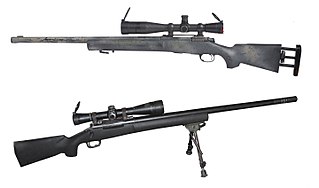
A sniper rifle is a high-precision, long-range rifle. Requirements include accuracy, reliability, mobility, concealment and optics for anti-personnel, anti-materiel and surveillance uses of the military sniper. The modern sniper rifle is a portable shoulder-fired weapon system with a choice between bolt-action or semi-automatic action, fitted with a telescopic sight for extreme accuracy and chambered for a high-ballistic performance centerfire cartridge.

Lyudmila Mikhailovna Pavlichenko, (Russian: Людми́ла Миха́йловна Павличе́нко, was a Soviet sniper in the Red Army during World War II, who was credited with 309 confirmed kills, making her the most successful female sniper in recorded history.
Nina Alexeyevna Lobkovskaya served as a sniper for the Red Army and attained the rank of Lieutenant in a separate sniper unit of the 3rd Shock Army during World War II. In the war she reached 89 confirmed kills, making her the tenth deadliest female sniper in the war.
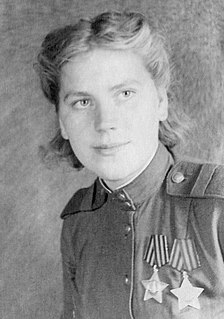
Roza Georgiyevna Shanina was a Soviet sniper during World War II who was credited with 59 confirmed kills, including twelve soldiers during the Battle of Vilnius. Shanina volunteered for the military after the death of her brother in 1941 and chose to be a sniper on the front line. Praised for her shooting accuracy, Shanina was capable of precisely hitting enemy personnel and making doublets.
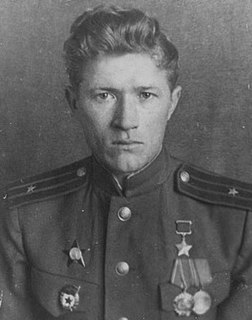
Ivan Mikhailovich Sidorenko was a Red Army officer and a Hero of the Soviet Union, who served during World War II. He was one of the top Soviet snipers in the war, with five hundred confirmed kills.

Soviet women played an important role in World War II. While most toiled in industry, transport, agriculture and other civilian roles, working double shifts to free up enlisted men to fight and increase military production, a sizable number of women served in the army. The majority were in medical units.

20th Century Battlefields is a BBC documentary television series hosted by television and radio personality Peter Snow, and his son Dan Snow.

The U.S. Army Sniper Course trains selected military members assigned to sniper positions in the skills necessary to deliver long-range precision fire and the collection of battlefield information. Students will receive training in fieldcraft skills, advanced camouflage techniques, concealed movement, target detection, range estimation, terrain utilization, intelligence preparation of the battlefield (IPB), relevant reporting procedures, sniper tactics, advanced marksmanship, and staff subjects.

Thomas Charles Richmond Baker, was an Australian soldier, aviator, and flying ace of the First World War. Born in Smithfield, South Australia, he was an active sportsman in his youth and developed a keen interest in aviation. He was employed as a clerk with the Bank of New South Wales, before he enlisted in the Australian Imperial Force in July 1915, for service in World War I. Posted to an artillery unit on the Western Front, he was awarded the Military Medal for carrying out numerous repairs on a communications line while subject to severe artillery fire. In June 1917, Baker was awarded a bar to his decoration for his part in quelling a fire in one of the artillery gun pits that was endangering approximately 300 rounds of shrapnel and high explosive.

Reports regarding the longest recorded sniper kills that contain information regarding the shooting distance and the identity of the sniper have been presented to the general public since 1967. Snipers in modern warfare have had a substantial history following the development of long distance weaponry. As weapons, ammunition, and aids to determine ballistic solutions improved, so too did the distance from which a kill could be targeted. In mid-2017 it was reported that an unnamed Canadian special forces operator, based in Iraq, had set a new record of 3,540 m (3,871 yd), beating the record previously held by an Australian sniper at 2,815 m (3,079 yd).
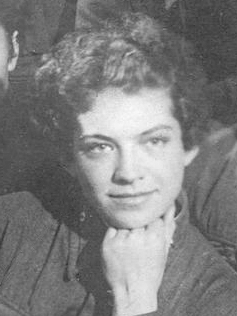
Natalya Kovshova was a Soviet female sniper who fought in World War II.
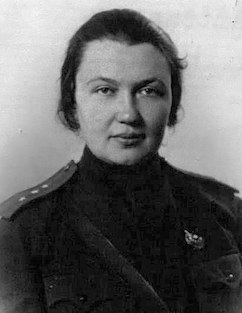
Nora Pavlovna Chegodayeva was a Soviet interpreter and translator. A Red Army officer during World War II, she was one of the organizers of a women's sniper course that became famous after its later reorganization as the Central Women’s Sniper Training School.

Zhambyl Tulaev was a sniper in the Red Army during World War II who was awarded the title Hero of the Soviet Union for his first 262 kills. Before the war, he was secretary of the Komsomol committee in his village and served as a commune chairman before undertaking transportation and distribution jobs. He was drafted in September 1941, serving in the infantry and taking part in the fighting on the Eastern Front. After leaving the military in 1946 he worked on collective farms and in the forestry industry. He also served on the Toltoy village council.
The 467th Guards District Training Centre for Junior Specialists of the Western Military District is a training formation of the Russian Ground Forces.

Ace, when used in the context of military propaganda, denotes a successful military professional who has accumulated a meaningfully measurable statistic such as aircraft shot down, tonnage sunk, or a number of successful sniper shots. In a manner analogous to sport statistics, some military roles can be measured in terms of a quantifiable metric. Once said metric is established, military personnel may be quantified versus the designated metric and compared in a tabular fashion. Such metrics may be used as a basis for military merit awards, such as Knight's Cross of the Iron Cross by setting an arbitrary threshold. Likewise, a designation of "ace" may be applied, such as 5 aircraft shoot downs.
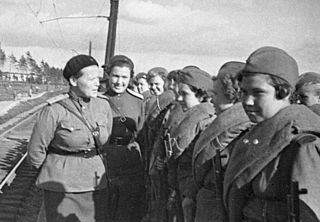
The Central Women's Sniper Training School was a Soviet military school for training female snipers for battle in the Second World War, more commonly referred to as the Great Patriotic War among Soviet Troops. Throughout the war the school trained 1061 snipers and 407 sniper instructors. The school yielded several highly successful snipers who became decorated veterans, and two graduates were posthumously awarded the title Hero of the Soviet Union.
















